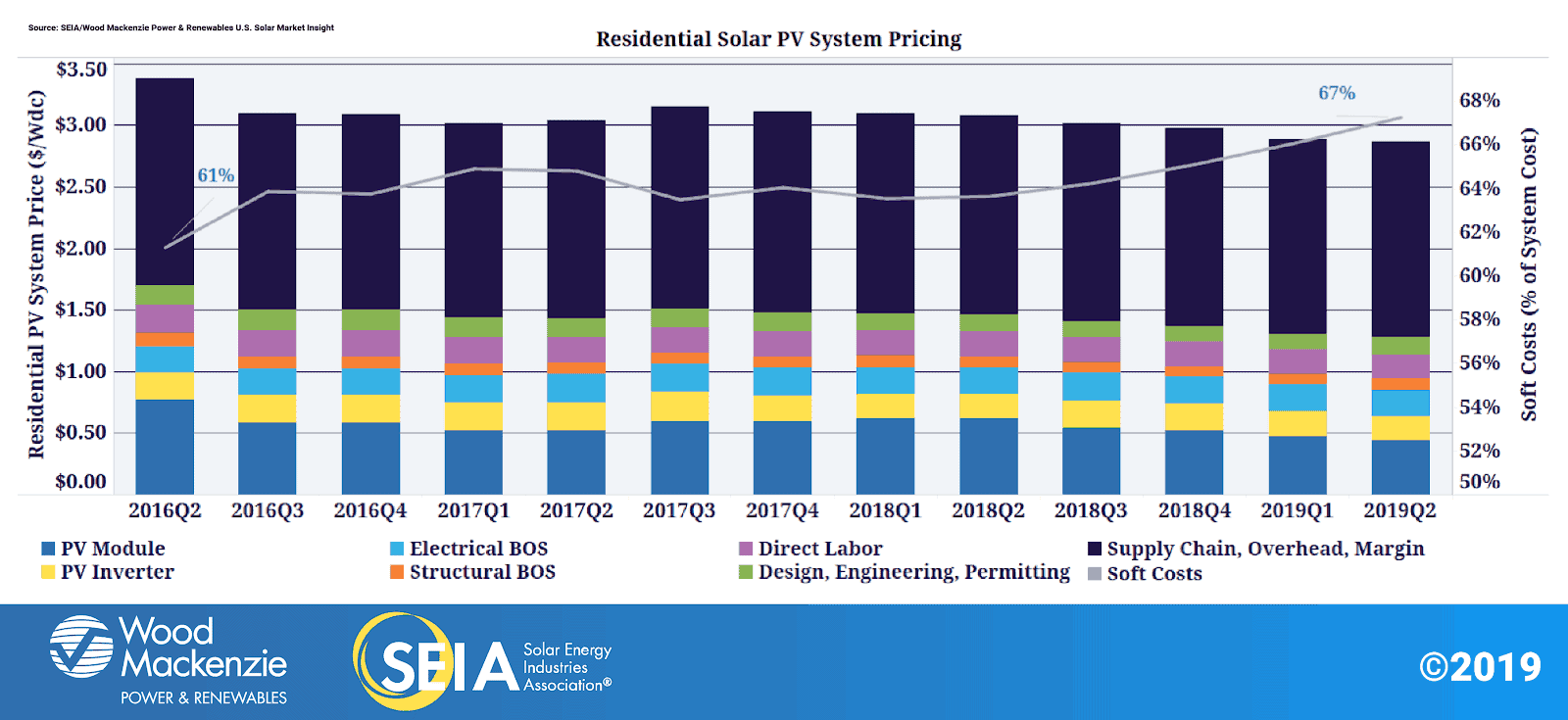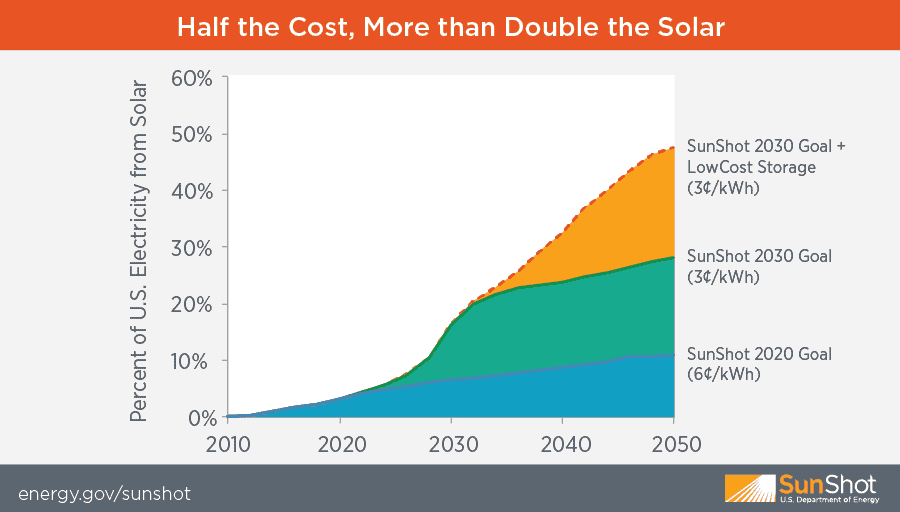If you work in the solar industry, chances are good that you’ve heard the term soft costs. But what does it mean and why should you care? Soft costs are a critical topic for the solar industry (and solar customers) because they are one of the barriers to making solar more affordable—and thus more accessible. In this article, we look at what soft costs are and what’s being done to address them.
What Are Soft Costs in the Solar Industry?
Soft costs are simply the “non-hardware costs associated with going solar” as the U.S. Department of Energy’s Office of Energy Efficiency & Renewable Energy explains. That includes the costs to acquire customers—from marketing and sales costs to assessing if a customer is a good candidate for solar based on their roof type and how much sunlight their property receives. It also includes the costs associated with permitting, interconnection to the grid, installation labor, and other assorted costs like supply chain and transaction costs.
 Soft costs, the non-hardware costs, of solar are made up of many components. Source: U.S. Department of Energy.
Soft costs, the non-hardware costs, of solar are made up of many components. Source: U.S. Department of Energy. Why Are Soft Costs So Important for the Solar Industry to Address?
Soft costs are vitally important to address because they represent one of the greatest opportunities to reduce the cost of solar PV. That’s because soft costs have remained stubbornly high—despite the fact that the cost of solar hardware, like panels, has fallen dramatically. (The cost of solar modules fell by 99% from 1980 to 2018!) Soft costs now comprise more than half of the cost of a solar PV system in the U.S.
As of Q1 2019, soft costs comprised 67% of the cost of a residential PV system according to the Solar Market Insight Report by the Solar Energy Industries Association (SEIA) and Wood Mackenzie Power & Renewables. SEIA calls soft costs the “biggest cost-decline opportunity in residential and small commercial solar.”
By lowering the cost of solar, soft cost reductions are a key step to getting more solar on the grid—thereby helping the solar industry to keep growing and mitigate climate change.
 Although the total cost of residential PV in the U.S. has declined over time, the proportion of soft costs—like supply chain and overhead, labor, design, permitting and engineering—has grown (see gray line). Source: SEIA and Wood Mackenzie Power & Renewables.
Although the total cost of residential PV in the U.S. has declined over time, the proportion of soft costs—like supply chain and overhead, labor, design, permitting and engineering—has grown (see gray line). Source: SEIA and Wood Mackenzie Power & Renewables. What Are the Opportunities If We Reduce Solar Soft Costs?
We’ve established that soft costs are high in the U.S. and represent the majority of the cost of a solar PV system—but that’s not the case everywhere. In fact, we see dramatic differences in soft costs in different countries. A 2018 report by Lawrence Berkeley National Laboratory (LBNL) report finds that solar installation soft costs “tend to be considerably higher in the U.S.”
Although hardware costs are relatively similar across countries, “the U.S. installed price was twice that of Germany’s $1.50/W and significantly higher than Australia’s $1.80/W, although both countries are comparable to the U.S. in other factors, like labor and safety standards,” explains Utility Dive, citing LBNL. Bringing down U.S. soft costs would help bring the cost of solar here in line with much the lower prices we see in these more mature solar markets.
A study by the Rocky Mountain Institute and the Georgia Tech Research Institute identified lessons from the Australian solar market for improving installation efficiency which could make solar installations faster in the U.S.—allowing installers to serve more customers and significantly reduce costs.
 As the cost of solar comes down, installations and the proportion of energy generated from solar go up. These projections from the U.S. Department of Energy’s (DOE) Sunshot initiative, while focused on the total cost of energy, illustrate the importance of reducing solar costs. Driving down soft costs, which comprise over half of the total cost of solar in the U.S., will be key. Source: DOE Sunshot Initiative.
As the cost of solar comes down, installations and the proportion of energy generated from solar go up. These projections from the U.S. Department of Energy’s (DOE) Sunshot initiative, while focused on the total cost of energy, illustrate the importance of reducing solar costs. Driving down soft costs, which comprise over half of the total cost of solar in the U.S., will be key. Source: DOE Sunshot Initiative. What’s Being Done to Lower Solar Soft Costs?
The importance of soft cost reductions to the growth of solar in the U.S. has not gone unnoticed. Solar industry groups and companies and the U.S. government have taken steps to bring these costs down by addressing a number of different factors. Approaches to lower soft costs range widely—from efforts to reduce customer acquisition costs to programs to streamline codes and permitting.
The DOE SunShot Initiative
One of the major efforts to reduce the cost of solar is the Department of Energy’s Sunshot Initiative. Launched in 2011, the program aimed to “reduce the total cost of solar energy by 75 percent,” setting ambitious targets for the Levelized Cost of Energy (LCOE) in residential, commercial, and utility-scale sectors. (In 2016 the program was 70% of the way to its 2020 targets, and in 2017, Sunshot announced that its 2020 utility-scale cost target was reached three years ahead of schedule.) While the initiative focuses on solar costs overall, supporting efforts to tackle soft costs has been one of the key ways that SunShot supports solar energy cost reductions.
Aurora Solar is a two-time Sunshot grant recipient for our efforts to make solar design and customer acquisition more efficient. One way that soft costs can be reduced is by eliminating some of the time-consuming manual labor involved in designing a solar installation for a customer and in assessing whether a prospect is a good fit for solar based on solar access/irradiance.
Aurora pioneered the ability of solar contractors to use software to remotely design an accurate PV system, using satellite imagery and other data like LIDAR and other 3D data, rather than driving out to the customer’s property to take measurements. The U.S. National Renewable Energy Laboratory (NREL) found that remote system design can reduce the cost of a solar installation by as much as $0.17/W—or $850 for a 5kW system!
Since the completion of our two Sunshot grants—one 2014 for R&D to automate the process of designing an optimal PV system and another in 2015 to pioneer the use of computer vision to improve remote site assessment speed and accuracy—we’ve continued our efforts to make solar contractors’ work easier and more efficient.
Solar APP: Streamlining Solar Permitting
Another important effort to reduce U.S. solar soft costs is the SolarAPP initiative, or Solar Automated Permit Processing program. Initiated by SEIA and The Solar Foundation in 2018, SolarAPP seeks to expedite and lower the cost of solar permitting.
Permitting is a key barrier to lower soft costs because the permit requirements for solar installations vary widely across jurisdictions. According to GTM, permitting adds about three months to a typical residential solar system installation and was responsible for about $1.00 of the 2017 median residential system cost of $3.70 per watt.
SolSmart
A related initiative by The Solar Foundation, the SolSmart Initiative, helps local governments reduce red tape and make their communities more supportive for the growth of solar energy. Over 300 communities have worked with the program to earn a SolSmart designation, indicating that they are solar-friendly communities.
California’s Solar Mandate: An Opportunity for Lower Soft Costs?
Another forthcoming policy, California’s Title 24 mandate which requires solar installations on all new homes starting in 2020, may also offer soft cost benefits. Citing NREL research, Utility Dive reports that the cost per watt of solar on new construction is likely to be considerably lower than traditional retrofit solar installations. Reduced customer acquisition costs, shared installation costs, and economies of scale are expected to drive these cost savings.
(Learn more about Title 24 here—and in our recent webinar with Solar Power World!)
Soft costs have stagnated for quite some time, keeping the cost of solar higher than it could be. However, there are many promising developments in the works, including our own initiatives here at Aurora, that are helping to reduce solar soft costs. With continued innovation and collaboration to tackle this issue, the future looks bright for affordable solar energy.
